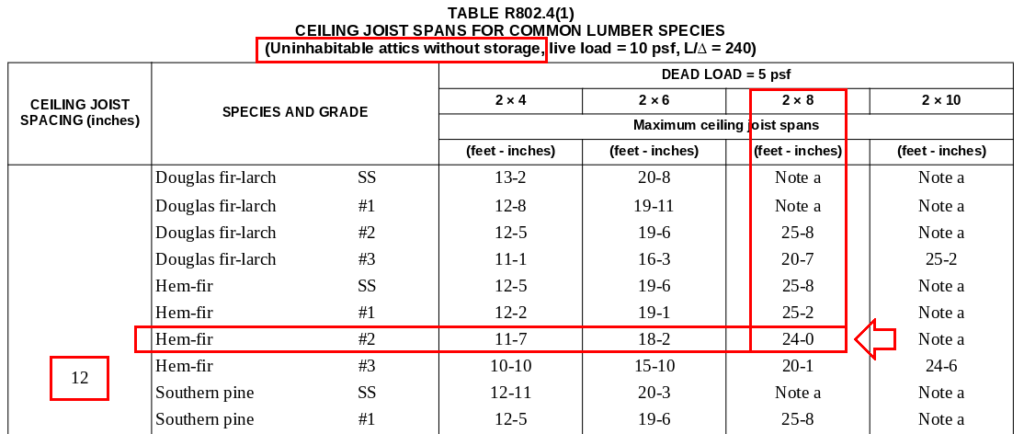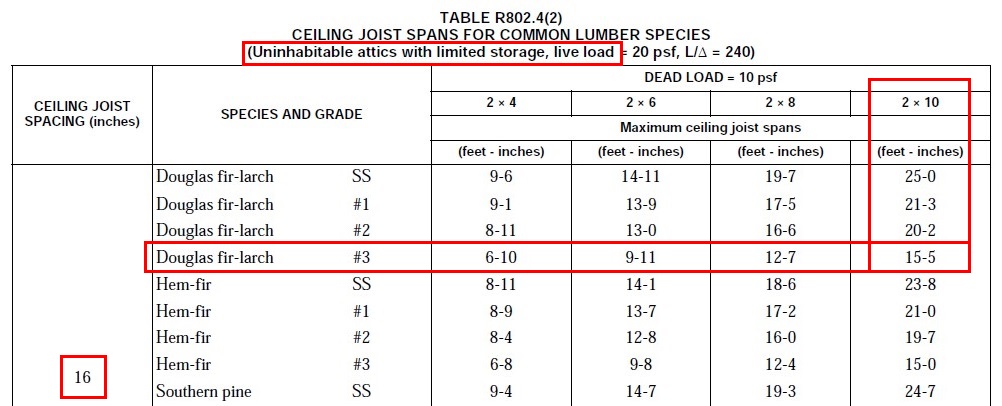Related Articles to Read:
- How to Size Floor Joists Per the IRC | Easily Explained with Examples
- How to Size Roof Rafters Per the IRC | Easily Explained with Examples
Want to learn how to easily size ceiling joists?
Chapter 8 of the 2015 International Residential Code (IRC) regulates the design and construction of roof and ceiling systems. Roof/ceiling members must be properly designed to ensure they provide adequate support as required by the loads that are imposed on them as well as making sure these loads are correctly transferred to the supporting walls and/or supporting structural elements.
The International Residential Code (IRC) recognizes two types of conventional roof and ceiling framing systems for buildings that are subject to the International Residential Code (IRC): wood framing and cold-formed steel framing. To understand what types of structures fall under the IRC, check out this Post.
In this post we will cover wood roof framing members, specifically ceiling joists. The design and construction of ceiling joists are found in section R802.4 of the IRC.
(Note: the table references have changed in the 2018 version of the IRC. The allowable ceiling joist span tables in the 2018 version are found in section R802.5. For the purpose of consistency, this post will reference the 2015 IRC. Please be aware of which version of the IRC you are using since the allowable spans can vary.)
In this post we will learn to correctly size a ceiling joist based on its span, spacing and type of lumber used.
Ceiling Joist Loads
Ceiling joists are sized based on one of two tables found in the code. These span tables list allowable ceiling joist spans for common lumber sizes based on what design load scenario is applied. Before we look at these tables, we need to make sure the correct design loads are determined prior to selecting the correct table.
The code recognizes 2 types of loads that are applied to ceiling joists: Live Loads and Dead Loads.
Live loads are defined by the code as follows:
Loads produced by the use and occupancy of the building or other structure. This does not include construction or environmental loads.
Dead loads are defined by the code as follows:
The weight of the materials of construction incorporated into the building, including but not limited to walls, floors, roofs, ceilings, stairways, built-in partitions, finishes, cladding, and other similarly incorporated architectural and structural items, and fixed service equipment.
Now for the case of sizing your ceiling joists, these loads vary depending on whether the attic space above is designed for with or without storage.
Attic Ceiling Joists Without Storage
If we look back at the definition above for live loads we can see that attic storage is considered a live load since this load is produced by the user given the nature of the space.
Basically if the space is large enough to accommodate storage of various items, the user will use the space as such. On the other hand if the space is too small to provide adequate space for storage, the user is limited or not physically capable of storing anything in such a small space.
In order to determine if an attic is considered an attic without storage, the code describes it as the following:
Uninhabitable attics without storage are those where the clear height between joists and rafters is less than 42 inches.

Therefore if you have an attic space according to this scenario, the ceiling joists can be designed for a live load of 10 pounds per square foot (psf) by using Table R802.4(1).
Attic Ceiling Joists With Limited Storage
Now if the space is large enough to provide adequate space for storage, the attic space shall be considered an attic space with limited storage.
In order to determine if an attic is considered an attic with limited storage, the code describes it as the following:
Uninhabitable attics with limited storage are those where the clear height between joists and rafters is 42 inches or greater.

Therefore if you have an attic space according to this scenario, the ceiling joists shall be designed for a live load of 20 pounds per square foot (psf) by using Table R802.4(2).
Ceiling Joist Span Tables
As mentioned above, the span tables within the code list the allowable ceiling joist spans for common lumber sizes based on what design load scenario is applied.
For uninhabitable attics without storage we will use Table R802.4(1) and for uninhabitable attic with limited storage we will use Table R802.4(2). Now lets take a look at those tables:
For simplicity, the table header is shown above. The tables header must be understood first before we can correctly size the ceiling joist. Each table is labeled. As you can see the first table is designed for attics without storage while the second table is designed for attics with limited storage.
The tables provide the following information:
- Ceiling Joist Spacing in inches (12, 16, 19.2, 24)
- Species and Grade of Lumber
- Various Lumber Size Options (2×4, 2×6, 2×8, 2×10)
- The maximum ceiling joist span based on the lumber size, species/grade, and spacing used.
Now, in order to correctly size ceiling joists, lets take a look at a few examples.
How to Size Ceiling Joists
Sizing Ceiling Joists – Example 1
Where Hem-fir #2 ceiling joists are spaced 12 inches on center in an uninhabitable attic without storage, what is the maximum allowable span for a 2×8 member?
First step, lets collect all the given information within the question:
- Attic without storage: Use Table R802.4(1)
- Ceiling Joist Spacing: 12 inches
- Species and Grade: Hem-fir #2
- Lumber Size used: 2×8
Now lets find the maximum allowable span for a 2×8 member given the above scenario:
Therefore given the above example, the maximum allowable span for a 2×8 member is 26′-0″.
Sizing Ceiling Joists – Example 2
Now lets try another example, but this time a span will be given and you must select the correct size lumber to be used given the following scenario:
Where Douglas fir-larch #3 ceiling joists are to be spaced 16 inches on center in an uninhabitable attic with limited storage, what is the minimum allowable joist size when required to span 15′-0″ in length?
First step, lets collect all the given information within the question:
- Attic with limited storage: Use Table R802.4(2)
- Ceiling Joist Spacing: 16 inches
- Species and Grade: Douglas fir-larch #3
Now lets find the minimum allowable joist size given the above scenario:
Therefore given the above example, the minimum allowable joist size for douglas fir-larch #3 lumber spanning 15′-0″ is a 2×10 since it can span 15′-5″. A 2×8 member for example cannot be used since it can only span 12-7″.
___
* Reference Source – 2015 International Residential Code – [Buy on Amazon]




